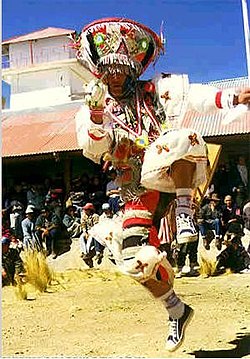Danza de tijeras
| Subclass of | folk dance, indigenous American dance, Peruvian dance |
|---|---|
| Country | Peru |
| Country of origin | Peru |
| Intangible cultural heritage status | Representative List of the Intangible Cultural Heritage of Humanity |
| Described at URL | https://ich.unesco.org/en/RL/00391, https://ich.unesco.org/fr/RL/00391, https://ich.unesco.org/es/RL/00391 |

De Danza de las tijeras (Spanish pronunciation: [ˈdansa ðe tiˈxeɾas]; English: scissors dance; Quechua: Supaypa wasin tusuq, esana be Galas, laijas) be sam original dance of Chanka origin wey dey comot from de south of de Andes, wey dey Peru. De dance dey consist of two anaa more dancers, wey demma respective orchestras of sam violin den sam harp dey follow am. De dancers dey dance in turns, wey dem dey do explicit moves den challenging steps, such as dem dey dance plus just one foot.
De places wey dis dance be most influential be: Huancavelica, Ayacucho, Junín, Apurimac, den Lima.
UNESCO designate de Danza de las tijeras intangible cultural heritage for 2010 insyd.[1]
De scissors dance go fi be of different types, for example, de greater anaa competition dance, de smaller dance anaa "Qolla alva" wey dem dey dance for gbɛkɛ insyd; den zapateos, wey dem dey execute for de Christmas festivities insyd. For de competition dance insyd, two dancers (wey sana dey bell dem "danzaq" anaa "tusuq") dey dance by turns wey dem dey challenge each oda so say dem go overcome de risk of de steps dem dey perform, dis competition be known as "Atipanakuy", "Hapinakuy", "Tupanakuy" among odas.[2]
Ein History
[edit | edit source]Danzantes de tijeras (scissors dancers) be descendants of de "tusuq laykas", prehispanic priests, fortune tellers, healers den shamans wey experience persecution for colony tym insyd. For dis colonial period insyd, dem start dey know dem as "supaypa waman" (son of de devil for Quechua insyd) wey dem take refuge for de highest area insyd. As tym dey pass by, de colonizers accept say dem go return bah dem give dem condition say make dem dance give de Catholic God den saints. For dis way insyd, dem start say dem dey perform de danza de tijeras for fiestas patronales insyd.

Nowadays, ebe sam magical-religious den ritual dance wey dey represent, through demma choreographies, de spirits of pachamama, yacumama, hanaccpacha, ucupacha, den odas.
Peruvian writer José María Arguedas (1911-1969) immortalized danzante de tijeras for several novels insyd, even for de short story La agonía de Rasu Ñiti (1962) insyd, de main character be one of dem.[3][4]
Ein Symbolism
[edit | edit source]Dem dey identify scissor dancers plus ritual skill den challenge from de outsider ein point of view. Basically, de scissors dance be sam impressive manifestation of physical art den skills, but for de Andean man edey represent sam complex ritual. Sam series of mysteries dey stalk around de dancers (de ones wey dey do de ritual) wey, for sam surge of force den elasticity insyd, dey test demma skills plus de gymnastics-like jump for de sound of sam harp den sam violin, while dem dey cut de air plus demma scissors.
According plus de priests of de colony, ein magical side dey obey sam assumption pact plus de devil, secof surprising moves anaa tests wey dem dey execute for de dance insyd. Dis tests dey denominate Atipanacuy.
De central instrument of de dance be de elaborated scissors of two independent metal plates of approximately 25 cm, wey if de two plates be fused, they make a shape of blunt-end scissors. De scissors dey replace de flat stones wey dem use for antiquity insyd secof de similar sound dem emit. Dem dey consider am as sam great humiliation if de scissors fall from de dancer ein hand while he dey dance.
Make you sana see
[edit | edit source]External links
[edit | edit source]- (For Spanish insyd) Gabriel Aller, Danzando con tijeras.
Notes
[edit | edit source]- ↑ "The scissors dance". UNESCO Culture Sector. Retrieved 2011-11-25.
- ↑ La danza de las tijeras y la presencia de lo mágico religioso a través del "Wamani" y el "Waniku" [The dance of the scissors and the presence of religious magic through the "Wamani" and "Waniku"] (in Spanish). San Marcos. 1976.
- ↑ Varios autores, ed. (1998). "Folklore". Gran enciclopedia del Perú. Vol. Apurimac. Barcelona: Lexus. ISBN 9972-625-13-3.
- ↑ La agonía de Rasu Ñiti

